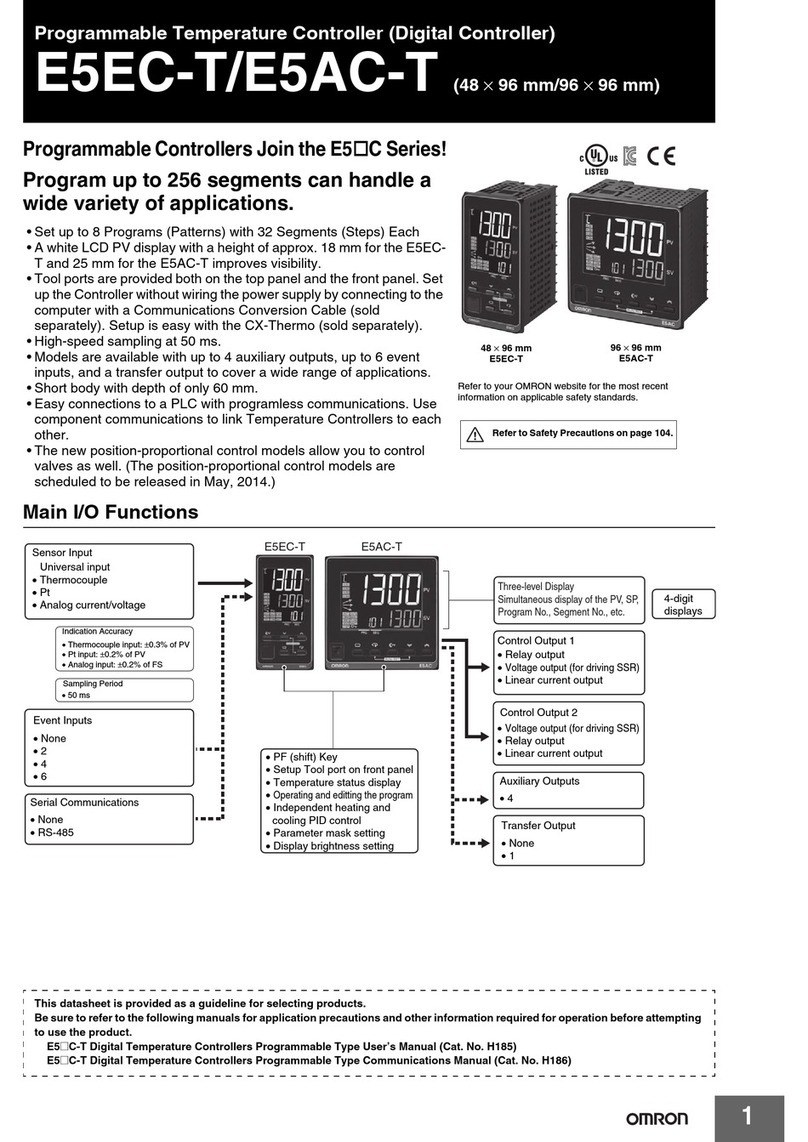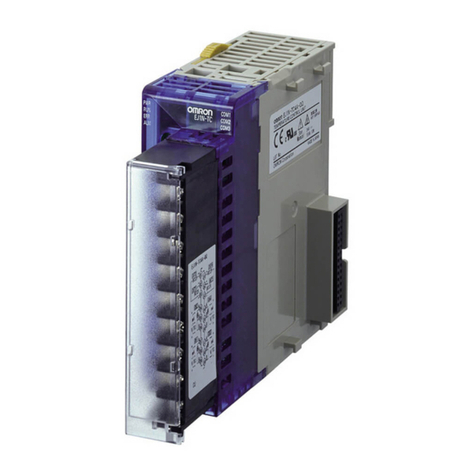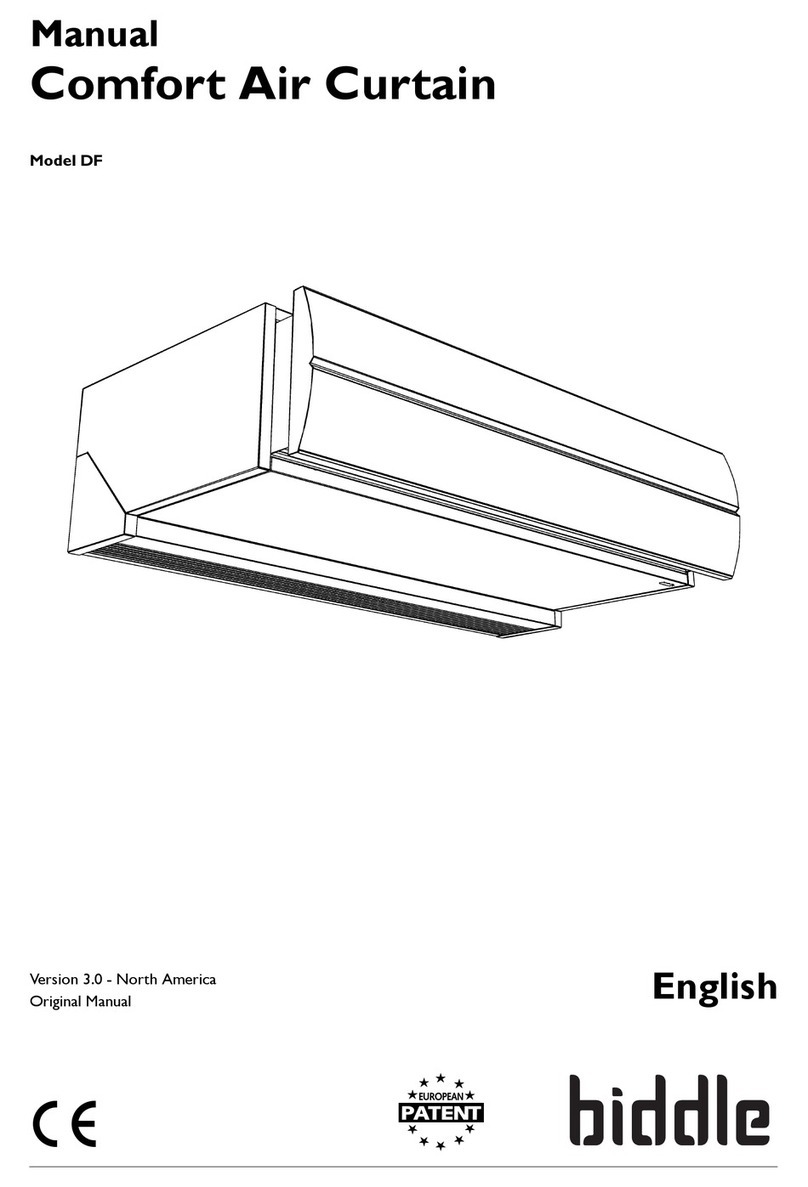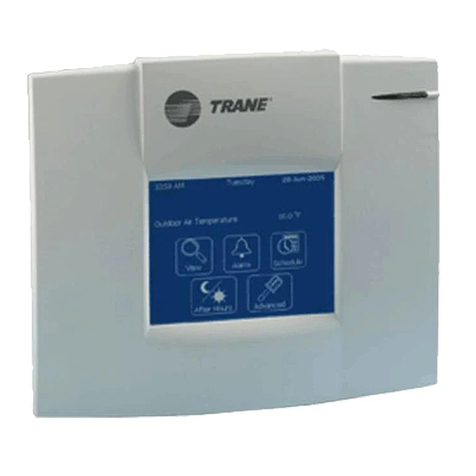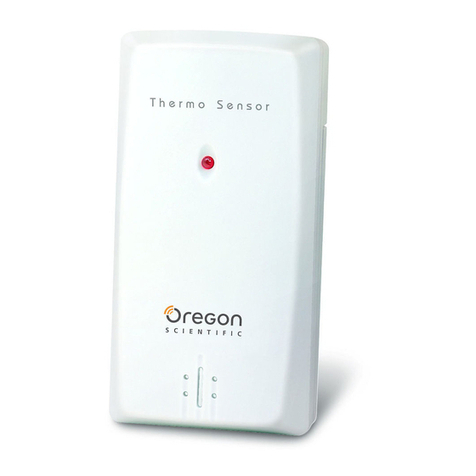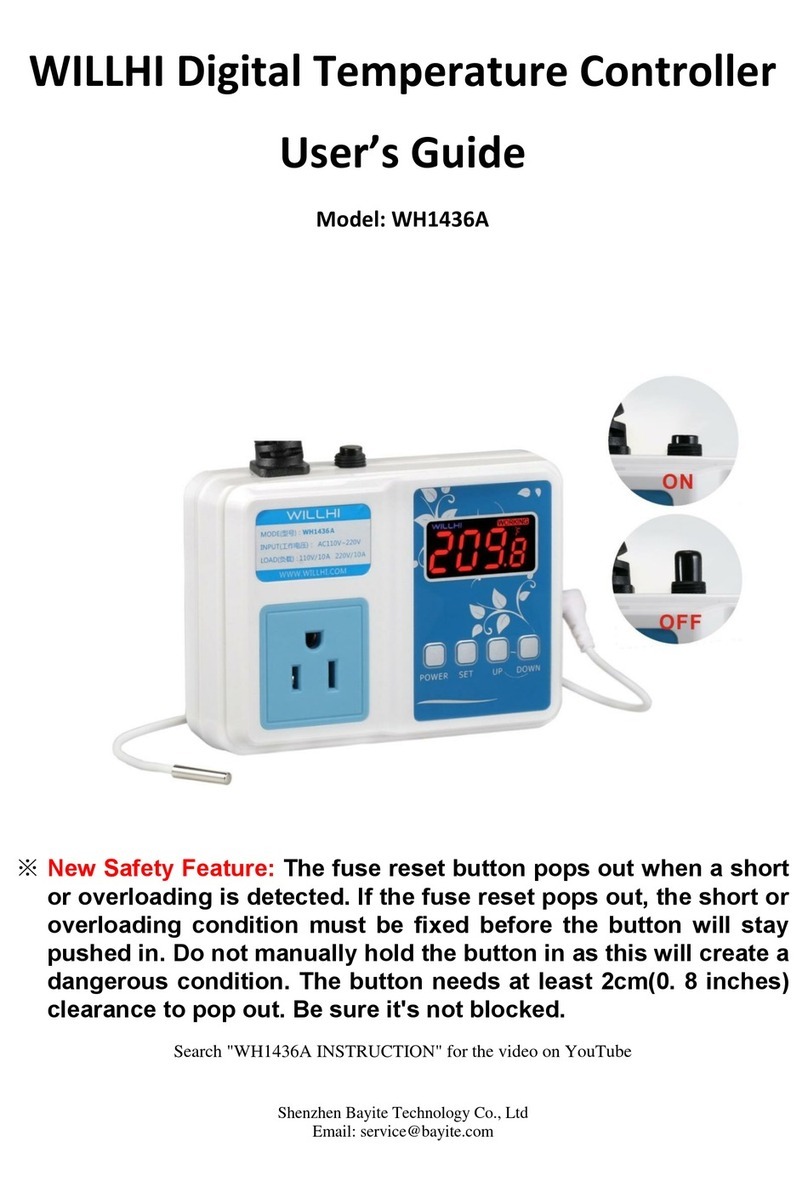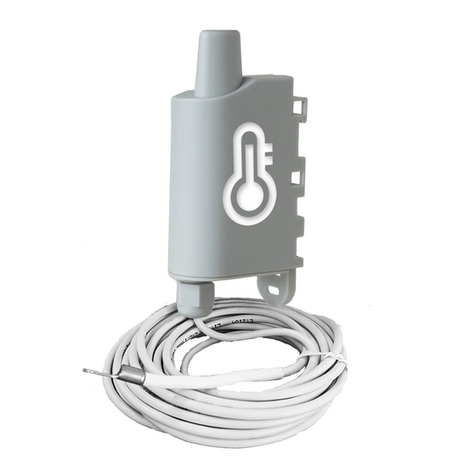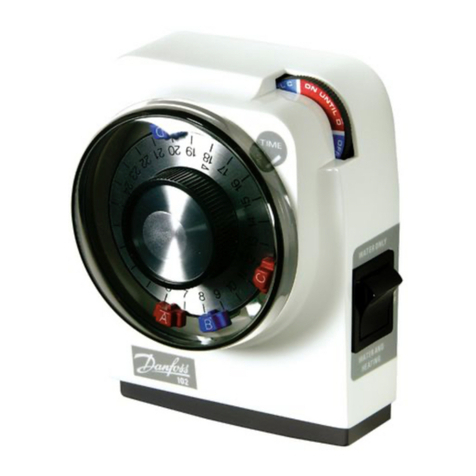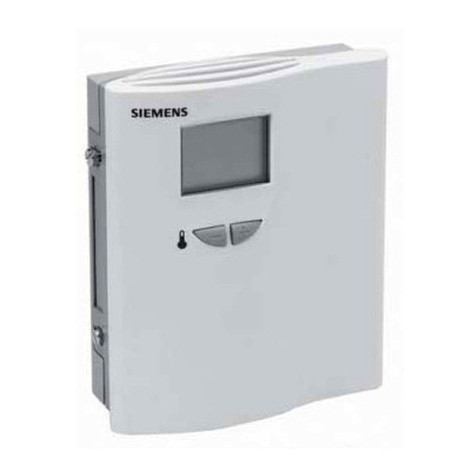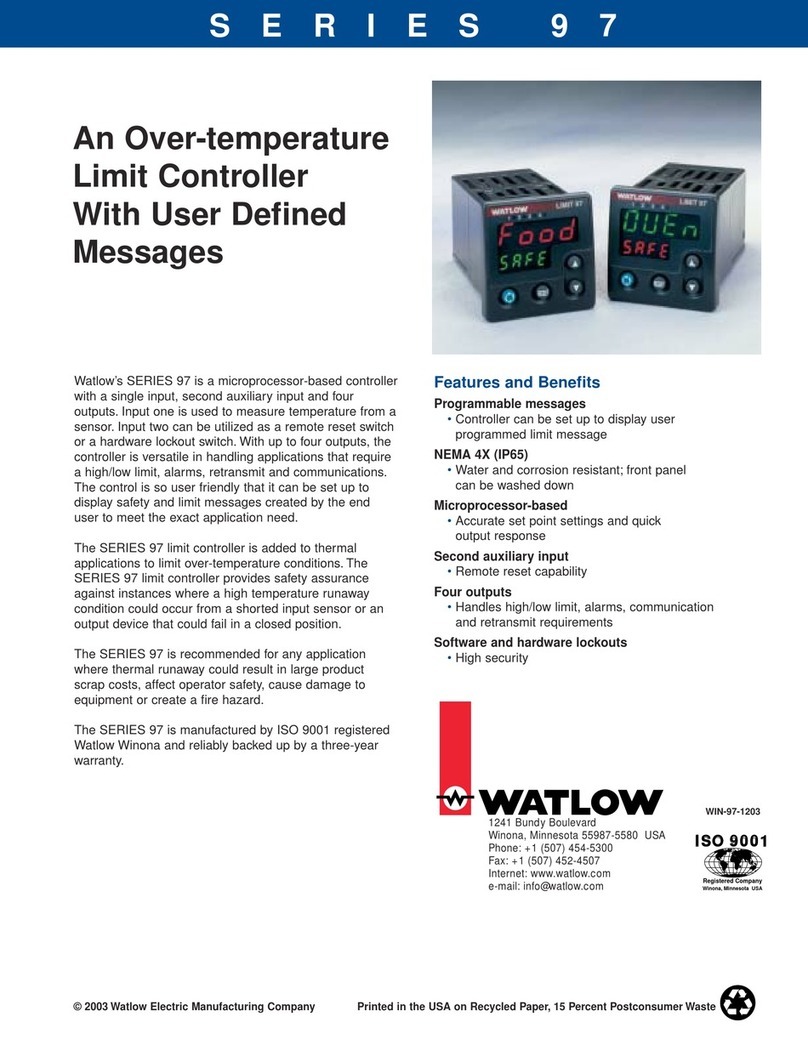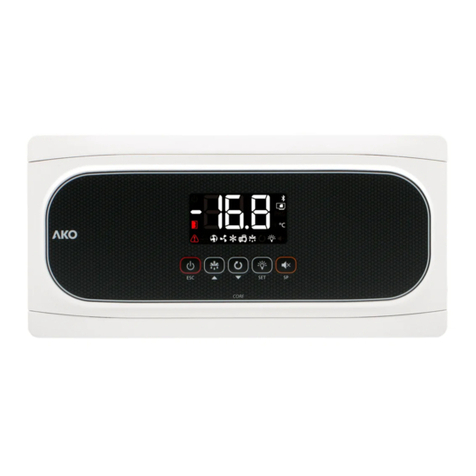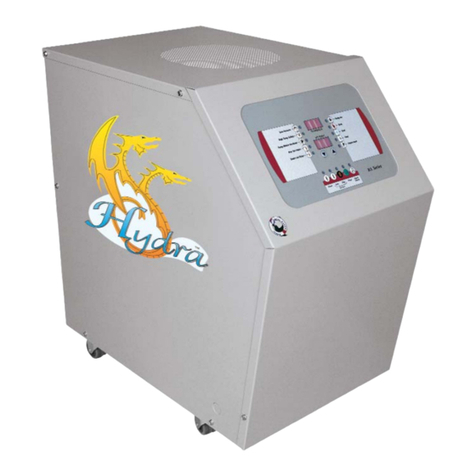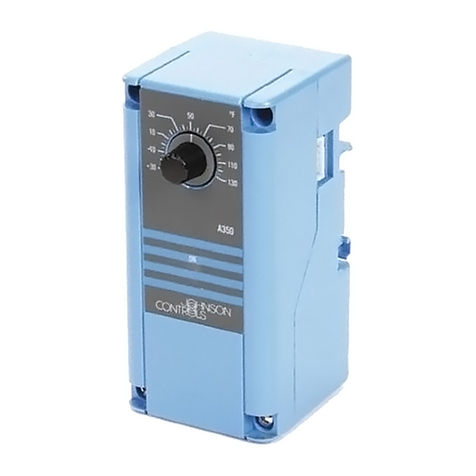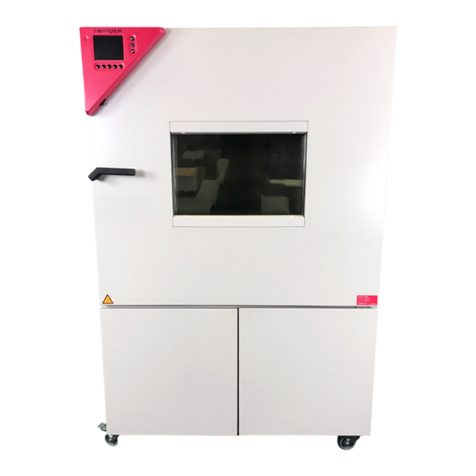Thermal Care RA Series User manual

Installation & Operation Manual
RA Series Temperature Control Unit

Page Intentionally Blank

Table of Contents
Foreword.............................................................................................................................................................................1
Installation ..........................................................................................................................................................................1
Receiving Inspection ...............................................................................................................................................................1
Rigging, Handling, and Locating Equipment............................................................................................................................1
Electrical Power ......................................................................................................................................................................1
Table 1 - Voltage Utilization Range ....................................................................................................................................1
Process Connections............................................................................................................................................................2
Start-Up...............................................................................................................................................................................3
Control Panel Operation ......................................................................................................................................................4
Table 2 - Microprocessor Control Fault Logic.....................................................................................................................4
Power ......................................................................................................................................................................................5
Start.........................................................................................................................................................................................5
Stop .........................................................................................................................................................................................5
Purge .......................................................................................................................................................................................5
Alarm Silence ..........................................................................................................................................................................5
Lower Set Point Temperature .................................................................................................................................................5
Raise Set Point Temperature ..................................................................................................................................................5
Low Pressure ...........................................................................................................................................................................5
High Temp Safety ....................................................................................................................................................................6
Pump Motor Overload ............................................................................................................................................................6
Over Set Point .........................................................................................................................................................................6
Under Set Point.......................................................................................................................................................................6
Pump On .................................................................................................................................................................................6
Heat.........................................................................................................................................................................................6
Cool .........................................................................................................................................................................................6
Vent.........................................................................................................................................................................................6
Probe Fault..............................................................................................................................................................................7
Changing Temperature Display Scale......................................................................................................................................7
Seal Saver™ .............................................................................................................................................................................7
Auto Tune................................................................................................................................................................................7
Diagnostic Error Codes............................................................................................................................................................9
Table 3 - Diagnostic Error Codes ........................................................................................................................................9
Control Options .................................................................................................................................................................10
Return Water Temperature Display......................................................................................................................................10
Remote On/Off Contacts ......................................................................................................................................................10
Remote Alarm Contacts ........................................................................................................................................................10
Alarm Horn............................................................................................................................................................................10
Remote Control Panel ...........................................................................................................................................................10
SPI Communications .............................................................................................................................................................10
Table 4 - SPI Baud Rate Adjustment .................................................................................................................................11
Operation .......................................................................................................................................................................... 11
Construction ......................................................................................................................................................................12
Pump Assembly.....................................................................................................................................................................12
Heater and Mixing Tube........................................................................................................................................................12
Heater (not available on RB and RBD units)..........................................................................................................................12
Cooling Solenoid or Modulating Valve..................................................................................................................................12
Pressure Switch.....................................................................................................................................................................12
Pressure Relief Valve.............................................................................................................................................................12
Standard Options...............................................................................................................................................................13
Stacking Bracket Kit (RA & RB series)....................................................................................................................................13
Mold Water Purge.................................................................................................................................................................13

Crash Cool .............................................................................................................................................................................13
Preventive Maintenance ................................................................................................................................................... 14
Once a Week .........................................................................................................................................................................14
Once a Month .......................................................................................................................................................................14
Troubleshooting ................................................................................................................................................................15
Charts & Pump Curves .......................................................................................................................................................16
Table 5 –Single-Zone Unit Electrical Specifications ..........................................................................................................16
Table 6 –Dual Zone Unit Electrical Specifications............................................................................................................17
Figure 1 –RA, RAD, RB, RBD Series Pump Curves ............................................................................................................18
Drawings ...........................................................................................................................................................................18
Warranty ........................................................................................................................................................................... 19

1
Foreword
The intent of this manual is to serve as a guide for placing your temperature control unit in service and operating and
maintaining it properly. This manual is supplemented as required to accommodate any special items that may have been
provided for a specific application. The written information contained in this manual, as well as various drawings, are
intended to be general in nature. The schematics included in this manual are typical only. Actual schematics are included
with the unit and should be referred to for troubleshooting and servicing of the unit. Additional copies of drawings are
available upon request. We strive to maintain an accurate record of all equipment during the course of its useful life. While
every effort is made to standardize the design features of these units, the various options may make it necessary to
rearrange some of the components; therefore, some of the general drawings in this manual may differ from your specific
unit.
Specific references to current applicable codes, ordinances, and other local laws pertaining to the use and operation of this
equipment are avoided due to their ever-changing nature. There is no substitute for common sense and good operating
practices when placing any mechanical equipment into operation. We encourage all personnel to familiarize themselves
with this manual's contents. Failure to do so may unnecessarily prolong equipment down time.
It is recommended that good piping practices are followed and that the information in this manual is adhered to. We
cannot be held responsible for liabilities created by substandard piping methods and installation practices external to the
unit.
We trust your equipment will have a long and useful life. If you should have any questions, please contact our Customer
Service Department specifying the serial number and model number of the unit as indicated on the nameplate.
Installation
Receiving Inspection
Each unit is skid mounted and boxed or crated to protect it during shipping. Before accepting delivery, check the box or
crate for visible damage. If damage is evident, it should be properly documented on the delivery receipt and the box or
crate should be immediately removed to allow for detailed inspection of the unit. Check for broken water lines, damaged
controls, or any other major component torn loose from its mounting point. Any sign of damage should be recorded and a
claim filed immediately with the shipping company. In order to expedite payment for damages it is important to record and
document damage. An excellent way to do this is by taking pictures. Our Customer Service Department will provide
assistance with the preparation and filing of your claims, including arranging for an estimate and quotation on repairs.
Rigging, Handling, and Locating Equipment
The units have a steel base platform and casters for easy positioning. For lifting, proper rigging methods must be followed
to prevent damage to components. Avoid impact loading caused by sudden jerking when lifting or lowering the unit. Use
pads where abrasive surface contact is anticipated.
The unit is designed for indoor use. If it is necessary to store the unit in an unheated area when not in use, be sure that all
water is drained or that an adequate amount of antifreeze is added to prevent freeze-up of the unit. A primary concern
when designing your unit was serviceability, therefore, the unit should be located in an accessible area.
Electrical Power
All wiring must comply with local codes and the National Electric Code. Minimum circuit ampacities and other unit electrical
data are on the unit nameplate and are shown in the Electrical Specification section at the back of this manual. A specific
electrical schematic is shipped with the unit. Measure each leg of the main power supply voltage at the main power source.
Voltage must be within the voltage utilization range given in Table 1 - Voltage Utilization Range.
Table 1 - Voltage Utilization Range
Rated Voltage
Utilization Range
230
208 to 254
460
414 to 506
575
516 to 633

2
If the measured voltage on any leg is not within the specified range, notify the supplier and correct before operating the
unit. Voltage imbalance must not exceed two percent. Excessive voltage imbalance between the phases of a three-phase
system can cause motors to overheat and eventually fail. Voltage imbalance is determined using the following calculations:
% Imbalance = (Vavg –Vx) x 100 / Vavg
Vavg = (V1+ V2+ V3) / 3
Vx= phase with greatest difference from Vavg
For example, if the three measured voltages were 442, 460, and 454 volts, the average would be:
(442 + 460 + 454) / 3 = 452
The percentage of imbalance is then:
(452 –442) x 100 / 452 = 2.2 %
This exceeds the maximum allowable of 2%.
A terminal block is provided for main power connection to the main power source. The main power source should be
connected to the terminal block through an appropriate disconnect switch. A separate lug for grounding the unit is also
provided in the main control panel. Electrical phase sequence must be checked at installation and prior to start-up. The
phasing must be checked with a phase sequence meter prior to applying power. The proper sequence should read “ABC” on
the meter. If the meter reads “CBA”, open the main power disconnect switch and switch two line leads on the line power
terminal blocks (or the unit mounted disconnect). All components requiring electric power are wired in-phase at the
factory. Do not interchange any load leads that are from the unit contactors or the motor terminals.
WARNING: It is imperative that L1-L2-L3 are connected in the A-B-C phase sequence to prevent equipment damage due to reverse
rotation.
WARNING: The control panel and safeties are wired such that connecting the appropriate power source to the main terminal block
energizes the entire electric circuitry of the unit. A control transformer has been factory wired to step down the incoming power to the
115-volt control power. Electric power at the main disconnect should be shut off before opening access panels for repair or
maintenance. The unit must be properly grounded in compliance with local and national codes.
Process Connections
The importance of properly sized piping or hose between the temperature control unit and the process equipment cannot
be overemphasized. In general, run full size piping out to the process and then reduce the pipe size to match the
connections on the process equipment. One of the most common causes of poor temperature control unit performance is
poorly designed piping. Avoid unnecessarily long lengths of hoses and piping as well as quick -disconnect fittings that offer
high resistance to water flow.
When manifolds are required for water distribution, they should be installed as close to the point of use as possible.
The return line should be the same size as the supply line. In addition to the process water connections, the unit requires a
cooling water supply and return connection. We recommend shut-off valves at each machine to allow for isolation and
removal of the unit.

3
Start-Up
Every unit is factory set to deliver temperature controlled water in accordance with the standard operating specifications
for that particular unit. Due to variables involved with different applications and different installations, minor adjustments
may be required during the initial start-up to ensure proper operation. The following start-up procedure should be followed
in sequence. If trouble is encountered during start-up, the fault can usually be traced to one of the control or safety devices.
This outline can be used as a checklist for the initial start-up and for subsequent start-ups if the unit is taken out of service
for a prolonged period.
1. Assure the main power source is connected properly, that it matches the voltage shown on the nameplate of the unit,
and that it is within the voltage utilization range given in Table 1 - Voltage Utilization Range. Electrical phase sequence
must be checked at time of installation and prior to start-up. Operation of the unit with incorrect electrical phase
sequencing will result in improper performance and potential damage. The phasing must be checked with a phase
sequence meter prior to applying power. The proper sequence should read “ABC” on the meter. If the meter reads
“CBA”, open the main power disconnect switch and switch two line leads on the line power terminal blocks (or the unit
mounted disconnect). All components requiring electric power are wired in-phase at the factory. Do not interchange
any load leads that are from the unit contactors or the motor terminals.
WARNING: It is imperative that L1-L2-L3 are connected in the A-B-C phase sequence to prevent equipment damage due to reverse
rotation.
2. Once proper power connection and grounding have been confirmed, turn the main power on.
3. Check all water line connections to ensure they are properly sized and installed. All water lines and connectors should
be rated for a minimum of 250°F (121°C) and 150 PSI (10.5 Bar). We recommend the cooling water supply and return
lines are of metal composition (black steel, galvanized or copper).
4. Check the pressure switch to ensure it is properly set for the intended operating temperature. The pressure switch is
factory set for 15 PSI (1.05 Bar) and the unit will not start unless the cooling water pressure is 15 PSI (1.05 Bar) or
greater. For set point temperatures above 200°F (93°C) the pressure switch should be set for a minimum of 25 PSI (1.75
Bar).
5. Make sure that the supply chilled water source is the appropriate temperature and pressure for your application as
determined when the unit was selected. In most cases, the cooling water temperature is between 40°F (4.4°C) and 85°F
(29.4°C). The cooling water source pressure must be above the set point of the pressure switch in order for the unit to
start. For most applications the design cooling water pressure is between 25 PSI (1.75 Bar) and 50 PSI (3.5 Bar). If the
supply cooling water pressure is higher than 50 PSI (3.5 Bar), a pressure-regulating valve should be installed on the
supply line to the temperature control unit. For assistance in installing a pressure-regulating valve, please contact our
Customer Service Department.
6. Turn on the control power by pressing the Power button located on the control panel of the unit. The digital displays
should now be illuminated. Press the Start button. The unit will initiate an Auto Vent sequence. This sequence opens
the cooling solenoid for 30 seconds to vent air from the system. After 30 seconds the cooling solenoid will remain open
and the pump will be energized for an additional 30 seconds. This should clear all of the air out of the system.
7. Check the rotation of the pump. If the pump is running backwards, switch two of the main power leads, after shutting
off the disconnect switch.
8. The set point temperature should now be entered. Refer to the Control Panel Operation section for further
information.
The unit is now ready to be placed into service.

4
Control Panel Operation
The temperature control unit includes a microprocessor controller designed to perform all control functions directly from
the front panel. When a button is pressed, a click will be felt and the corresponding LED will be energized.
The table shown below provides the basic control fault logic for the microprocessor controller.
Table 2 - Microprocessor Control Fault Logic
Fault
Alarm
Indication
Pump Shut
Off
Heater Shut
Off
Unit Shut Off
Alarm
Reset
Required1
Manual
Reset
Required2
Remote
Alarm
Activated3
Low Pressure
LED
Yes
Yes
Yes
No
No
Yes
High Temperature Safety
LED
Yes
Yes
Yes
Yes
No
Yes
Pump Motor Overload
LED
Yes
Yes
Yes
Yes
Yes
Yes
Over Set Point
LED
No
No
No
No
No
Yes
Under Set Point
LED
No
No
No
No
No
Yes
Probe Fault
LED
Yes
Yes
Yes
Yes
No
Yes
Low Power
Pr OFF
Yes
Yes
Yes
Yes
No
Yes
1 Alarm Reset button or Stop button on control panel must be pressed.
2 Safety control must be manually reset before the controller can be reset.
3 Activates the alarm horn (if included) and closes the alarm contact (if included).

5
Power
Depressing the Power button will switch the control power on or off. When the Power button is pushed the microprocessor
initiates a diagnostic routine to determine if a brownout has occurred. The Power button must be pushed to initiate control
power before either the Start button or remote on/off contacts can start the unit.
Start
Depressing the Start button will start the pump and enable the microprocessor control functions and initiate an Auto-vent
sequence.
The Auto Vent sequence is designed to remove air from the water circuit of the process equipment. For the first 30 seconds
of the sequence the cooling valve is opened to allow air to escape. After this, the valve is left open and the pump is
energized for the remaining 30 seconds of the sequence to further remove air from the system.
Stop
Depressing the Stop button will stop the pump, stop any Auto Tune sequence, clear all faults and suspend the
microprocessor control program.
Purge
Pressing the Purge button will open the cooling solenoid or modulating valve. This feature is designed to allow the mold
circuit to be purged of water with compressed air. It will only function if the power is on but the heater and pump are off.
This feature should be used only after pressing the Stop button. The external valves and associated parts required for
compressed air connection are an available option from our parts department.
Alarm Silence
The Alarm Silence button is only functional if the Alarm Horn option and/or Remote Alarm Contact option has been
purchased. If the Alarm Horn option has been purchased, depressing the Alarm Silence button will disable the horn. The
horn will not reactivate until the alarm has been reset and a subsequent alarm has been triggered. If the Remote Alarm
contacts option has been purchased, depressing the Alarm Silence button will open the contact that was closed when the
alarm occurred. The contact will not close again until the alarm has been reset and a subsequent alarm has been triggered.
Lower Set Point Temperature
Depressing and then releasing the Lower Set Point Temperature button will decrease the set point temperature by 1°F (or
1°C). If the Lower Set Point Temperature button is held down, the set point temperature will continue to decrease until the
button is released or the minimum allowable set point temperature is reached.
Raise Set Point Temperature
Depressing and then releasing the Raise Set Point Temperature button will increase the set point temperature by 1°F (or
1°C). If the Raise Set Point Temperature button is held down, the set point temperature will continue to increase until the
button is released or the maximum allowable set point temperature is reached.
Low Pressure
The Low Pressure LED will be illuminated if the inlet cooling water pressure drops below the set point of the low-pressure
safety switch. If a low-pressure condition occurs, the unit will automatically stop and remain de-energized until the cooling
water pressure rises back above the cut-in set point of the pressure switch.

6
High Temp Safety
The High Temp Safety LED will be illuminated if the To Process temperature exceeds 260°F (127°C). The High Water
Temperature LED will turn off when the water temperature is less than 260°F (127°C). This fault will stop operation of the
unit. To clear this fault after the fault condition has been corrected, depress the Stop button; restart the unit by depressing
the Start button.
Pump Motor Overload
The Pump Motor Overload LED will be illuminated if the motor overload opens. This fault will stop operation of the unit. To
clear this fault after the fault condition has been corrected, depress the Stop button; restart the unit by depressing the Start
button.
Over Set Point
The Over Set Point LED will be illuminated if the To Process temperature exceeds the Set Point temperature by more than
5°F (3°C). This fault causes only an alarm indication (horn and/or remote contact) and the unit will continue to operate.
Although the Over Set Point LED will turn on immediately whenever the temperature is out of range, the alarm relay is
disabled for 30 minutes after start-up or after a change in set point. The alarm will automatically clear when the To Process
temperature is no more that 5°F (3°C) above the Set Point temperature.
Under Set Point
The Under Set Point LED will be illuminated if the To Process temperature drops below the Set Point temperature by more
than 5°F (3°C). This fault causes only an alarm indication (horn and/or remote contact) and the unit will continue to
operate. Although the Under Set Point LED will turn on immediately whenever the temperature is out range, the alarm
relay is disabled for 30 minutes after start-up or after a change in set point. Pressing the Alarm Reset button will reset this
fault.
Pump On
The Pump On LED will be illuminated whenever the pump is running. If the pump is shut off due to a safety, the Pump On
LED will turn off. The Start button must be pressed in order to restart the pump.
Heat
The Heat LED will be illuminated when the microprocessor determines that heating is required. For those units with
heaters, the Heat LED will be illuminated while the heater is energized. For units without heaters, the Heat LED illuminates
depending on unit set point parameters.
Cool
The Cool LED will be illuminated when the microprocessor determines that cooling is required. The Cool LED will be
illuminated while the cooling solenoid or modulating valve coil is energized, or when the compressed air purge option is
used during the Auto Vent sequence.
Vent
The Vent LED will be illuminated while the microprocessor is performing an Auto Vent sequence. This sequence is
performed each time the Start button is pressed to energize the unit unless the temperature is above 150°F (65°C). The
Auto Vent sequence opens the cooling solenoid or modulating valve for 30 seconds to vent air from the mold circuit. Then
the valve is kept open and the pump is energized for an additional 30 seconds. The Vent LED will also be on when the
optional compressed air purge is used.

7
Probe Fault
The Probe Fault LED will illuminate if the signal from the thermocouple is out of tolerance. This fault will also shut off the
compressor and the pump. Pressing the Alarm Reset button will reset this alarm.
Changing Temperature Display Scale
This unit was shipped to display temperatures in either °F or °C. The following step can be followed to determine what
temperature scale is in use and will provide instructions as to how to change from one scale to another.
1. Disconnect main power.
2. Open the control panel and switch DIP switch #3 to the on position and close control panel.
3. Reconnect main power.
4. With the power connected and the control power off, hold down the Stop button. While holding the Stop button down,
press the Power button. When the controller illuminates, release both buttons.
5. The To Process display will read "Unt". The Set Point display will show either "F" or "C" depending on the current
display units selected. If "F" is displayed the temperature display is in °F mode. If "C" is displayed the temperature
display is in °C mode.
6. To change from °F to °C press the Lower Set Point Temperature button. To change from °C to °F press the Raise Set
Point Temperature button.
7. The Set Point display now indicates the desired display units.
8. Press and release the Start button to store the new selection into the controller memory.
9. Press and release the Power button once to exit the function. Press and release the Power button again to restore
controller power.
10. Disconnect main power.
11. Open the control panel and switch DIP switch #3 to the off position and close control panel.
12. Reconnect main power.
The unit is now set and will remain set with the selected temperature scale until the above steps are repeated.
Seal Saver™
Each unit has a Seal Saver program built into the controller that can be activated when turning off the unit. This software is
designed to reduce water temperature before the unit shuts off to extend the life of the seal. Here is how to activate this
feature:
1. Press the Start button and while holding in the Start button, momentarily press the Stop button. Both keys can then be
released.
2. The solenoid valve will remain open, bringing cool water to the unit. This will continue until either the temperature of
the water reaches 90°F (32°C) or for 120 seconds, whichever occurs first.
3. Once activated, the Stop LED will flash and the Set Point display will toggle between the actual set point and the 90°F
(32°C) Seal Saver cool down value. The actual set point can be changed at this time if desired.
4. When the water reaches 90°F (32°C) or 120 seconds have elapsed, the control will enter the normal stop mode. The
Stop LED will discontinue flashing and the Set Point display will revert to the actual set point value.
5. Seal Saver will not activate if the Process Temperature is less than 90°F (32°C). If the Stop button is pressed at any point
during Seal Saver operation, the unit will stop all operation. If the Start button is pressed at any point during Seal Saver
operation, the unit will return to normal running operation, at the original set point.
6. Seal Saver will not activate under the following circumstances: Auto Tune is running, the first 60 seconds of operation,
or if the set point is under 90°F (32°C).
This process must be repeated every time you wish to activate Seal Saver. To deactivate Seal Saver, change the
configuration DIP switch #2 to the "Off" position.
Auto Tune
In most cases, the standard program entered into the microprocessor controller at the factory provides excellent
temperature control; however, there are occasions where a particular application may require additional fine-tuning of the
control parameters. To make this procedure as simple as possible, this controller has been equipped with an Auto Tune
function.

8
The Auto Tune function is designed to automatically select the best control parameters based upon the particular system
that the unit is connected to. At the factory, certain parameters have been limited so that the Auto Tune program cannot
select values that could cause damage to certain components. The following procedure should be followed if there is a
need for the Auto Tune program to be run.
Note: Do not use the Auto Tune function until it is verified that the unit is operating normally and there is not a failure of
a component. Make sure that the lines are properly sized and there is sufficient incoming water pressure. If the
application is for heating, other changes are needed and you should contact our Customer Service Department.
1. Make sure that the flow and pressure through the process are set at the proper levels for that particular installation.
Poor temperature control accuracy is often caused by low coolant flow through the process.
2. The Auto Tune program must be run with no heat load being added by the process. The program may take up to 30
minutes to run.
3. To activate Auto Tune, change DIP switch #8 to the "On" position.
4. The unit must be in the stop mode and the process temperature must be at ambient.
5. Hold the Start button down for 7 seconds.
6. The Auto Tune program will abort under these conditions:
a. Pressing the Stop button while Auto Tune is in progress.
b. If the temperature difference between the process value and the set point is less than 8°F (4.5°C) after the
vent sequence.
c. The software is unable to obtain a good approximation of the PID parameters after 30 minutes has elapsed.
This condition can occur if the control loop was disturbed by external elements or if the control elements are
faulty.
If any of the above conditions occur, the previous control parameters will be restored.
7. To abort the Auto Tune program at any time, press the Stop button, and the previous control parameters will be
restored.

9
Diagnostic Error Codes
Several different error codes may be displayed on the digital readouts labeled To Process and Set Point. Most of the
possible error codes indicate some type of failure in the microprocessor controller. Below is a list of the error codes. If there
are any error codes other than the one listed below, try to reset the unit by shutting the power off and then turning it back
on. If this does not work, make a note of the error code and contact our Customer Service Department for further
assistance.
Table 3 - Diagnostic Error Codes
Error
Description
Cause/Corrective Action
Pr Off
Brown Out Indication
The Pr Off code will be indicated on the display if the unit is running and main power is discontinued or
drops more than 10% below the normal operating voltage, the unit will shut down and the Pr OFF fault
will be indicated on the digital displays. Pressing the Stop button will clear this fault condition.
101
EEPROM Failure
Controller requires servicing. Contact Manufacturer for repair or replacement.
102
A/D Converter Failure
Controller requires servicing. Contact Manufacturer for repair or replacement.
103
Controller serial bus failure
Controller requires servicing. Contact Manufacturer for repair or replacement.
105
CJC Error
Controller requires servicing. Contact Manufacturer for repair or replacement.
109
Unused memory byte changed
Controller requires servicing. Contact Manufacturer for repair or replacement.
110
Device or communication
configuration change or invalid
Controller requires servicing. Contact Manufacturer for repair or replacement.
111
Fixed parameter associated with
range invalid
Controller requires servicing. Contact Manufacturer for repair or replacement.
112
Set point out of temperature
range
Controller requires servicing. Contact Manufacturer for repair or replacement.
113
RAM hardware failure
Controller requires servicing. Contact Manufacturer for repair or replacement.
114
Invalid device configuration
Controller requires servicing. Contact Manufacturer for repair or replacement.
117
Invalid program counter
Controller requires servicing. Contact Manufacturer for repair or replacement.
118
Infinite software loop detect
Controller requires servicing. Contact Manufacturer for repair or replacement.
119
Data direction register failure
Controller requires servicing. Contact Manufacturer for repair or replacement.
120
Communication data register
failure
Controller requires servicing. Contact Manufacturer for repair or replacement.
121
Timer data register failure
Controller requires servicing. Contact Manufacturer for repair or replacement.
122
Hardware watchdog data register
failure
Controller requires servicing. Contact Manufacturer for repair or replacement.
123
Option data register failure
Controller requires servicing. Contact Manufacturer for repair or replacement.
125
Jumper for temperature
controller missing
The Err 125 fault code will be indicated on the digital displays if the jumper is loose or missing on the
control circuit board.
129
Input Contact Chatter
Controller requires servicing. Contact Manufacturer for repair or replacement.

10
Control Options
Return Water Temperature Display
This option allows the To Process digital display to indicate To Process or Return Water temperatures. To view the Return
Water temperature, hold down the Lower Set Point Temperature and Raise Set Point Temperature buttons simultaneously.
Once the buttons are released, the display will return to the To Process temperature.
Remote On/Off Contacts
This option allows the unit to be turned on and off via a remote contact closure. Two terminals are provided in the control
panel to be wired to a remote contact closure device. Switching the contacts from open to close simulates pressing the
Start button on the control panel. Switching the contacts from closed to open simulates pressing the Stop button. Please
note that the Remote On/Off contacts are nonfunctional until the Power button has been depressed and the control circuit
has been energized. This option also includes a remote/local toggle switch that allows the operator to disable the remote
contacts for safety purposes while the unit is being serviced.
Note: Do not introduce any external voltage to these contacts, as this will result in damage to the microprocessor, which will not be covered by the
warranty.
Remote Alarm Contacts
This option includes a set of dry (no voltage induced by the unit), normally open contacts that will close when there is an
alarm condition. Refer to Table 2 for the Microprocessor Control Fault Logic to determine which faults will trigger the
Remote Alarm contacts. The contacts will reopen by clearing the fault or by pressing the Alarm Silence button.
Alarm Horn
This option includes an alarm horn that will be activated by certain faults. Refer to Table 2 for the Microprocessor Control
Fault Logic to determine which faults will trigger the Alarm Horn. The Alarm Horn will be silenced by clearing the fault or by
pressing the Alarm Silence button. If this option is selected in conjunction with the remote control panel, the Alarm Horn
will be mounted on the unit and not the remote control panel.
Remote Control Panel
This option removes the display and control buttons from the unit and places them in a small hand-held NEMA-1 enclosure.
Included with this option is a 50 Ft (15 M) cable to connect the controller and the unit. All control functions are available to
the operator at the location of the remote panel and no control functions are available at the location of the unit.
SPI Communications
This option provides an RS-485 communication port located below the control panel on the front of the unit. The serial
communications will be multi-drop, half duplex, SPI 3.01 compatible and will allows the unit to communicate with another
piece of equipment that also has SPI protocol capabilities.
The following SPI communications are supported by the microprocessor.
Process Temperature Set Point
High Temperature Deviation
Low Temperature Deviation
Process Status
To Process Temperature
The microprocessor is designed to accept inputs and deliver outputs according to SPI protocol. There must also be a
computer or another piece of equipment that is equipped with the SPI protocol in order for the communications from the
unit to be of any use. The programming of this computer and/or other equipment is not the responsibility of the
manufacturer.
Note: The manufacturer is not responsible for SPI protocol programming beyond what is included in the microprocessor controller.
When the SPI option is purchased, there is a second set of DIP switches included on the back of the main control panel. This
set of DIP switches is labeled "COMM". All DIP switch adjustments that follow are to be made on the COMM set. Do not
adjust any DIP switches on the CONFIG set.

11
Note: All DIP switch changes must be made with power disconnected.
In order to activate the SPI protocol, DIP switch #8 must be set to the "On" position. To deactivate the SPI communication,
set DIP switch #8 to the "Off" position.
If more than one piece of equipment is going to be on the same communications network, the base address will have to be
changed so that each unit has a unique address. This is done by changing one or more of the DIP switches to the "Off"
position. The base address is 32 decimal. Changing these switches causes the following address change.
DIP Switch 1 OFF adds one to base address
DIP Switch 2 OFF adds two to base address
DIP Switch 3 OFF adds four to base address
DIP Switch 4 OFF adds eight to base address
DIP Switch 5 OFF adds sixteen to base address
The BAUD rate can be adjusted to the appropriate setting by using the information found in Table 4.
Table 4 - SPI Baud Rate Adjustment
BAUD Rate
DIP Switch #6
DIP Switch #7
1200
ON
ON
2400
Off
ON
4800
ON
Off
9600
Off
Off
Operation
The temperature control unit cycles a heater and cooling valve to maintain precise temperature control of the To Process
water temperature. Your unit may differ somewhat depending upon the various options purchased; however, the overall
function of the unit is fundamental to all our temperature control units.
The pump continuously pumps water from the mixing tube through the heater tube and out to the process equipment. The
water is pumped through the process equipment at a high flow rate to ensure turbulent flow and efficient heat transfer.
Once the water exits the process equipment it returns to the mixing tube.
A thermocouple is mounted at the exit of the heater tube to measure the temperature of the To Process water
temperature. This temperature is used by the microprocessor to determine if temperature adjustment is required. If the
water temperature is below set point, the heater is energized. Conversely, the cooling solenoid or modulating valve is
opened whenever the water temperature is above set point. Opening the cooling solenoid or modulating valve allows some
of the warm water from the process water circuit to exit through the cooling water out line. At the same time, cool water is
injected into the process circuit from the cooling water in line. The replacement of warm water with cool water provides
the cooling that is required. The cooling valve is cycled by the microprocessor to allow precisely controlled amounts of
cooling water to enter the system.
A bypass line is provided to protect the pump from overloading during those times when the process water circuit is shut
off. This prevents the pump from a deadheading situation and ensures flow through the pump to keep the pump seal from
overheating.
A pressure switch is provided to ensure that there is sufficient inlet cooling water pressure to allow the unit to operate
without the possibility of steam flashing. A pressure relief valve is provided to vent the process loop if the operating
pressure becomes too high.
WARNING: Do not plug the opening in the pressure relief valve under any circumstances, as this is safety device that must not be
defeated.
A small pump seal flush line is provided to continuously flush the pump seal of dirt and debris.

12
Construction
Pump Assembly
The centrifugal close-coupled pump features a specially designed cast volute to eliminate fittings and provide easy
connection to the heater and/or mixing tubes. The pump volute is constructed of cast iron. The ¾ through 2 HP pumps have
stainless steel impellers and pump shafts. The 3 HP through 7½ HP pumps have an iron impeller with a bronze wear ring in
the pump volute and carbon steel shafts with a bronze sleeve covering. All pump sizes use a carbon Ni-Resist mechanical
pump seal. All pumps include a pump seal flush line.
Heater and Mixing Tube
Depending on the options and heater KW capacity of the unit, there will be either two heater tubes or a heater tube and a
mixing tube. Both the heater and mixing tubes have been designed to match up to the pump volute casting. The tubes are
constructed of cast iron and are designed to connect with the pump volute with two flange seals. Units with 0 KW through
12 KW heating capacity will include a larger heater tube and a smaller mixing tube. Units with heating capacities of 18 KW
or 24 KW will have two larger heater tubes and no mixing tube.
Heater (not available on RB and RBD units)
The heaters are vertical flange mounted with Incoloy heater element sheathing. All units will use one or more 9 KW or 12
KW heater elements. The heaters are energized whenever the microprocessor determines that heating is required.
Cooling Solenoid or Modulating Valve
The cooling solenoid or modulating valve meters the cooling water required for proper cooling. The valve allows warm
water to leave the process loop while letting cooling water to enter the loop. This valve is also used to vent the process
circuit during Vent and/or Purge sequences.
Pressure Switch
All units are equipped with a pressure switch to ensure that the unit will not start until the inlet cooling water pressure
exceeds the pressure switch setting. This safety protects the heater and pump seal from potential damage caused by lack of
water as well as ensuring that the system pressure is above the vapor pressure of the water to prevent the water from
flashing to steam.
WARNING: If the Set Point temperature is 200°F (93°C) or higher, the pressure switch should be set for a minimum of 25 PSI (1.75 Bar).
The pressure switch is mounted on the back of the vertical panel that separates the electrical components from the
pump/heater section of the unit. The pressure switch can be adjusted by using the screws located on top of the pressure
switch. When looking at the front of the pressure switch, the left-hand screw adjusts the differential and the right-hand
screw adjusts the set point. The differential is factory set for 10 PSI (.7 Bar) and should not need to be changed. The set
point can be adjusted by turning the right-hand screw until the set point indicator points to the desired pressure.
Pressure Relief Valve
The pressure relief valve is a safety device designed to vent the system if the operating pressure exceeds 150 PSI (10.5 Bar).
The pressure relief valve is located on one of the heater tubes. The pressure in the process loop is the sum of the cooling
water supply pressure and the pressure added by the temperature controller pump. It is possible that a high pressure
cooling water source and/or a low flow application will cause periodic pressure relief valve venting during normal
operation. If you are experiencing this, please contact our Customer Service Department for assistance and have the serial
number and model number of the unit as shown on the nameplate located on the back of the unit.

13
Standard Options
The following options are the most common standard options that we offer. In addition to the options shown, we specialize
in offering unique options for our customers as are needed for their particular application. If you are unable to find
information on an option of your unit, please refer to the drawings that were shipped with the unit or contact our Customer
Service Department for further information.
Stacking Bracket Kit (RA & RB series)
RA Series units can be stacked to minimize floor space requirements. A stacking bracket kit can be used to allow one unit to
be placed on top of another.
Mold Water Purge
The mold water purge option allows the mold circuit to be purged of water by an external compressed air source. For
shipping purposes, the kit is shipped separately and will require field installation. To perform a mold purge, follow the steps
below in sequence.
1. Press the Stop button. This leaves the unit on but puts the microprocessor in an inactive mode. The Power button light
should still be illuminated.
2. Close the valve on the Cooling Water In line to shut off the supply of water.
3. Connect the compressed air supply to the ¼" ball valve on the back of the unit.
4. Open the ¼" ball valve to let the compressed air into the mold circuit.
5. Press the Purge button on the control panel and hold it down for 30 to 60 seconds or until the connecting water lines
stop shaking. When the water lines stop shaking you can assume that the water has been purged.
6. Close the ¼" ball valve and disconnect the compressed air line.
7. Close the valves on the Cooling Water Out, From Process and To Process lines.
8. Open the pressure bleed line to pressurize the mold circuit. After the pressure is relieved, disconnect the hoses from
the mold. The purge cycle is now complete.
Crash Cool
This option provides an additional solenoid valve piped in parallel to the vent/cooling solenoid valve. When activated, more
cooling water is allowed into the system providing quicker process cooling. Enabling the Crash Cool switch located on the
left side of the control panel activates this function. The Crash Cool solenoid valve will remain open as long as the Crash
Cool switch is enabled.
Heat Exchanger (RA & RAD series)
The heat exchanger option uses a 4.0 ft² copper tube heat exchanger to isolate the cooling water source from the process
water after the process is initially filled with water. The heat exchanger is designed to fit within a heater tube. Due to space
restrictions in the cabinet, this option is only available on units with 0 KW through 12 KW heating capacities. The process
circuit is filled separately by bypassing cooling water into the process circuit. The cooling supply line will be used for
expansion during operation. This option also includes a separate vent solenoid valve.

14
Preventive Maintenance
Once the unit has been placed into service, the following maintenance procedures should be adhered to as closely as
possible. The importance of a properly established preventive maintenance program cannot be overemphasized. Taking the
time to follow these simple procedures will result in substantially reduced downtime, reduced repair costs, and an
extended useful lifetime for the unit.
The following is a list of suggested periodic maintenance.
Once a Week
1. Check to make sure that the To Process temperature is maintained reasonably close to the Set Point temperature. If
the temperature stays more than 2°F (2°C) away from the set point, there may be a problem with the unit If this is the
case, refer to the Troubleshooting Chart or contact our Customer Service Department.
2. Check the pump discharge pressure. Investigate further if the pressure starts to stray away from the normal operating
pressure.
3. Check the pump for leaks in the seal area. Replace pump seal if necessary.
Repeat items 1 through 3 listed above and continue with the following.
Once a Month
4. With the main disconnect shut off, check the condition of electrical connections at all contactors, starters and controls.
Check for loose or frayed wires.
5. Check the incoming voltage to make sure it is within 10% of the design voltage for the temperature control unit.
6. Check the amp draws to each leg of the pump motor and heater to confirm that they are drawing the proper current.

15
Troubleshooting
Problem
Possible Cause
Remedy
Alternating overheating
and overcooling or rapid
cycling from heat to cool
Poor water flow
Check connectors and increase size if necessary. If there are a large number of
hoses and/or they are long, try to short hose runs and use as large of a hose as
possible to minimize water circuit pressure drop. If quick disconnects with check
valves have been used, remove the check valves to reduce pressure drop through
water circuit.
Poor connection or failure of
thermocouple
Check connection, replace if necessary
Failure of the microprocessor
Replace controller
Unable to heat properly
Solenoid valve is stuck in the open
position
Flush out the solenoid valve by adjusting the Set Point up and down several times
to open and close the solenoid valve. If this does not work, stop the unit and turn
off the electric power and water and take the solenoid valve apart for cleaning or
replacement
Leaking connection and/or the
manual pressure relief valve is in an
open condition
Check for leaks and replace any faulty valves
Immersion heater is inoperative
Have a qualified electrician check to see if the heater and/or heater contactor are
functioning correctly and replace any defective components.
Microprocessor controller failure
Replace controller
Failure of thermocouple
Replace thermocouple
Failure of heater
Replace heater
Failure of heater contactor
Replace heater contactor
Unable to cool properly
Cooling water supply is not sufficient
Check to make sure the cooling water supply is of sufficient temperature, volume
and pressure for the unit.
Drain (cooling water return line) is
not sufficient
Check the drain (cooling water return line) to ensure there is no restriction
preventing cooling water flow to the drain (cooling water return line).
Solenoid valve is inoperative
Check the drain (cooling water return line) and see if you can feel or hear a change
in the flow as the solenoid valve open and closes. If you cannot hear or feel the
flow it is likely the solenoid valve has failed. Replace solenoid valve if necessary.
Plugged heat exchanger (only on
models with heat exchanger option)
Clean or replace heat exchanger
High backpressure in the cooling
water system
Reduce backpressure. Call our Customer Service Department for assistance on
selecting a pressure-regulating valve.
Heater failure
Unit not filled with water
Fill unit with water
Faulty heater
Replace heater
Plugged heater tube / flow restriction
Clear obstruction

16
Charts & Pump Curves
Table 5 –Single-Zone Unit Electrical Specifications
Model
Heater(s)
Pump
Unit MCA2
Qty
KW
FLA Each (3-phase, 60 Hz)
Qty
HP
FLA Each (3-phase, 60 Hz)
Amps (3-phase, 60 Hz)
208V1
230V1
460V1
575V1
208V1
230V1
460V1
575V1
208V1
230V1
460V1
575V1
RA0908
1
9
24.9
22.6
11.3
9.0
1
0.75
3.7
3.4
1.7
1.4
35.3
32.2
16.3
13.2
RA0910
1
9
24.9
22.6
11.3
9.0
1
1
3.7
3.4
1.7
1.4
35.3
32.2
16.3
13.2
RA0920
1
9
24.9
22.6
11.3
9.0
1
2
6.6
6.0
3.0
2.4
38.2
34.8
17.6
14.2
RA093A
1
9
24.9
22.6
11.3
9.0
1
3
9.9
9.0
4.5
3.6
41.5
37.8
19.1
15.4
RA093B
1
9
24.9
22.6
11.3
9.0
1
3
9.9
9.0
4.5
3.6
41.5
37.8
19.1
15.4
RA0950
1
9
24.9
22.6
11.3
9.0
1
5
16.5
15.0
7.5
6.0
48.1
43.8
22.1
17.8
RA0975
1
9
24.9
22.6
11.3
9.0
1
7.5
24.2
22.0
11.0
8.8
55.8
50.8
25.6
20.6
RA1208
1
12
33.0
30.0
15.0
12.0
1
0.75
3.7
3.4
1.7
1.4
45.5
41.4
21.0
16.9
RA1210
1
12
33.0
30.0
15.0
12.0
1
1
3.7
3.4
1.7
1.4
45.5
41.4
21.0
16.9
RA1220
1
12
33.0
30.0
15.0
12.0
1
2
6.6
6.0
3.0
2.4
48.4
44.0
22.3
17.9
RA123A
1
12
33.0
30.0
15.0
12.0
1
3
9.9
9.0
4.5
3.6
51.7
47.0
23.8
19.1
RA123B
1
12
33.0
30.0
15.0
12.0
1
3
9.9
9.0
4.5
3.6
51.7
47.0
23.8
19.1
RA1250
1
12
33.0
30.0
15.0
12.0
1
5
16.5
15.0
7.5
6.0
58.3
53.0
26.8
21.5
RA1275
1
12
33.0
30.0
15.0
12.0
1
7.5
24.2
22.0
11.0
8.8
66.0
60.0
30.3
24.3
RA1808
2
9
24.9
22.6
11.3
9.0
1
0.75
3.7
3.4
1.7
1.4
66.5
60.4
30.5
24.4
RA1810
2
9
24.9
22.6
11.3
9.0
1
1
3.7
3.4
1.7
1.4
66.5
60.4
30.5
24.4
RA1820
2
9
24.9
22.6
11.3
9.0
1
2
6.6
6.0
3.0
2.4
69.4
63.0
31.8
25.4
RA183A
2
9
24.9
22.6
11.3
9.0
1
3
9.9
9.0
4.5
3.6
72.7
66.0
33.3
26.6
RA183B
2
9
24.9
22.6
11.3
9.0
1
3
9.9
9.0
4.5
3.6
72.7
66.0
33.3
26.6
RA1850
2
9
24.9
22.6
11.3
9.0
1
5
16.5
15.0
7.5
6.0
79.3
72.0
36.3
29.0
RA1875
2
9
24.9
22.6
11.3
9.0
1
7.5
24.2
22.0
11.0
8.8
87.0
79.0
39.8
31.8
RA2408
2
12
33.0
30.0
15.0
12.0
1
0.75
3.7
3.4
1.7
1.4
86.7
78.9
39.7
31.9
RA2410
2
12
33.0
30.0
15.0
12.0
1
1
3.7
3.4
1.7
1.4
86.7
78.9
39.7
31.9
RA2420
2
12
33.0
30.0
15.0
12.0
1
2
6.6
6.0
3.0
2.4
89.6
81.5
41.0
32.9
RA243A
2
12
33.0
30.0
15.0
12.0
1
3
9.9
9.0
4.5
3.6
92.9
84.5
42.5
34.1
RA243B
2
12
33.0
30.0
15.0
12.0
1
3
9.9
9.0
4.5
3.6
92.9
84.5
42.5
34.1
RA2450
2
12
33.0
30.0
15.0
12.0
1
5
16.5
15.0
7.5
6.0
99.5
90.5
45.5
36.5
RA2475
2
12
33.0
30.0
15.0
12.0
1
7.5
24.2
22.0
11.0
8.8
107.2
97.5
49.0
39.3
RB08
0
0
0.0
0.0
0.0
0.0
1
0.75
3.7
3.4
1.7
1.4
4.2
3.9
2.2
1.9
RB10
0
0
0.0
0.0
0.0
0.0
1
1
3.7
3.4
1.7
1.4
4.2
3.9
2.2
1.9
RB20
0
0
0.0
0.0
0.0
0.0
1
2
6.6
6.0
3.0
2.4
7.1
6.5
3.5
2.9
RB3A
0
0
0.0
0.0
0.0
0.0
1
3
9.9
9.0
4.5
3.6
10.4
9.5
5.0
4.1
RB3B
0
0
0.0
0.0
0.0
0.0
1
3
9.9
9.0
4.5
3.6
10.4
9.5
5.0
4.1
RB50
0
0
0.0
0.0
0.0
0.0
1
5
16.5
15.0
7.5
6.0
17.0
15.5
8.0
6.5
RB75
0
0
0.0
0.0
0.0
0.0
1
7.5
24.2
22.0
11.0
8.8
24.7
22.5
11.5
9.3
Notes:
1. Voltage utilization range is: 208 (187 to 254), 230 (187 to 254), 460 (414 to 508), and 575 (518 to 635).
2. Unit MCA (Minimum Circuit Ampacity) is based upon 125% of the largest FLA plus 100% of remaining components FLA.
This manual suits for next models
35
Table of contents
Other Thermal Care Temperature Controllers manuals
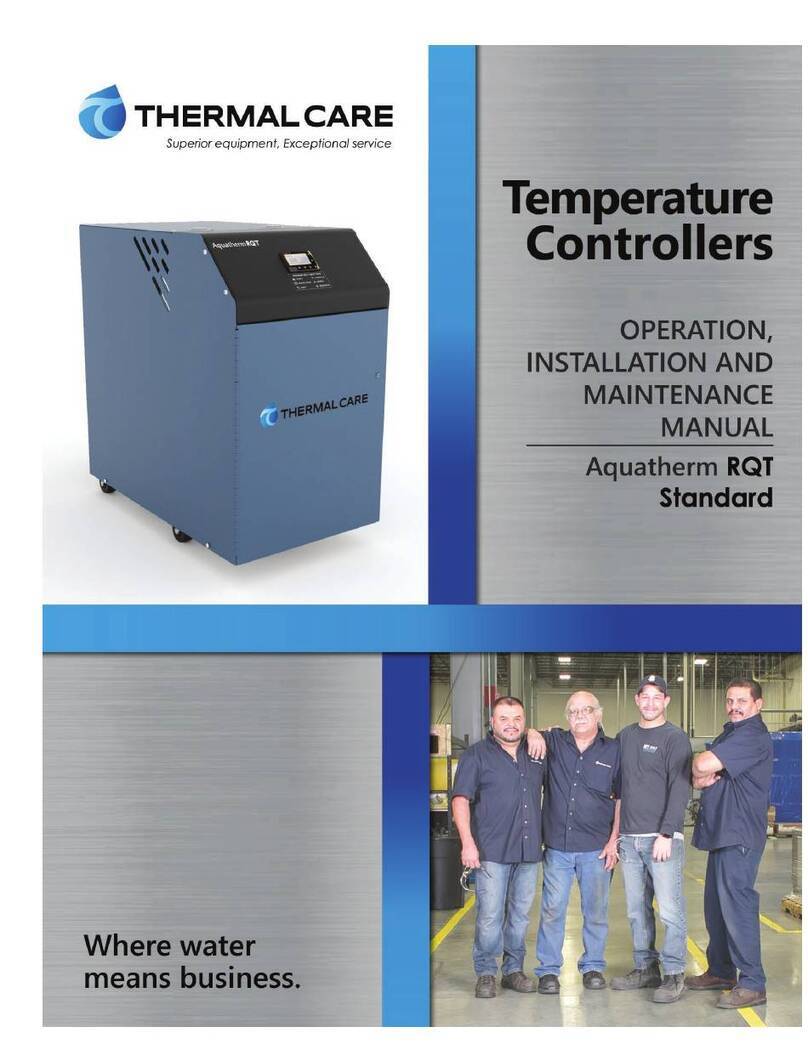
Thermal Care
Thermal Care Aquatherm RQT Standard Instruction Manual
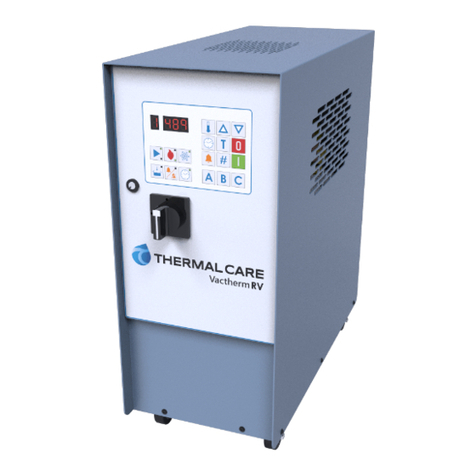
Thermal Care
Thermal Care Vactherm RV Instruction Manual
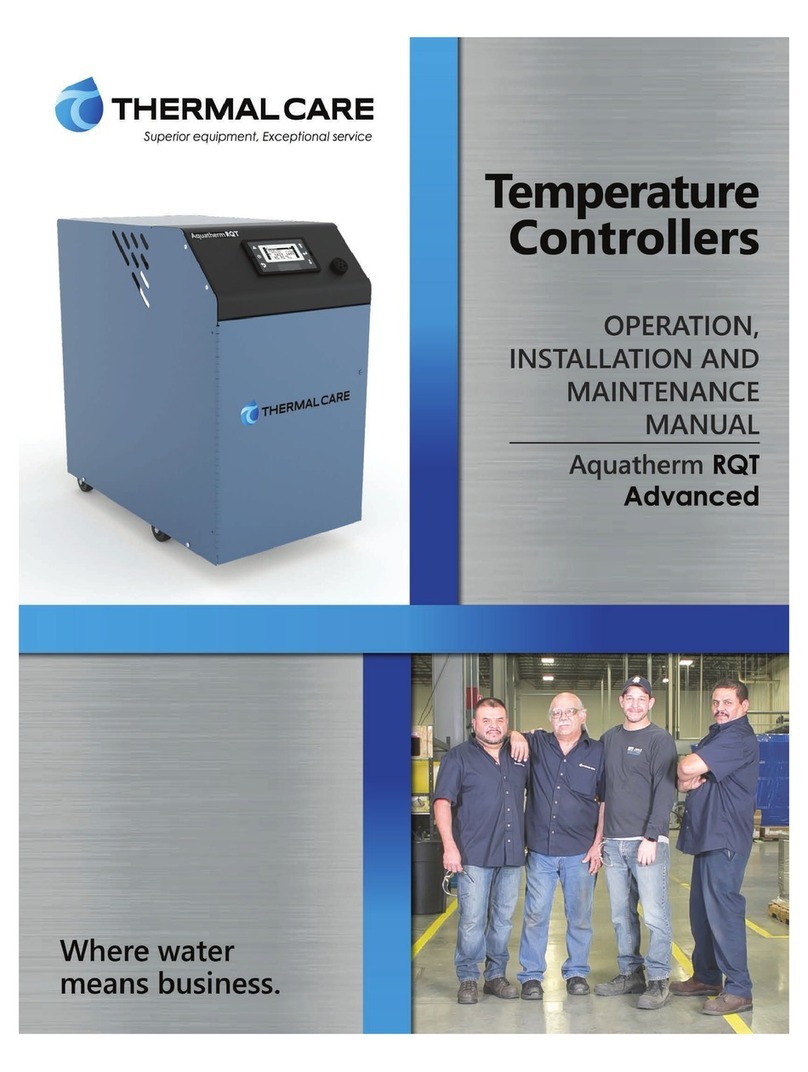
Thermal Care
Thermal Care Aquatherm RQT Advanced Instruction Manual

Thermal Care
Thermal Care Aquatherm RQT Premium Instruction Manual
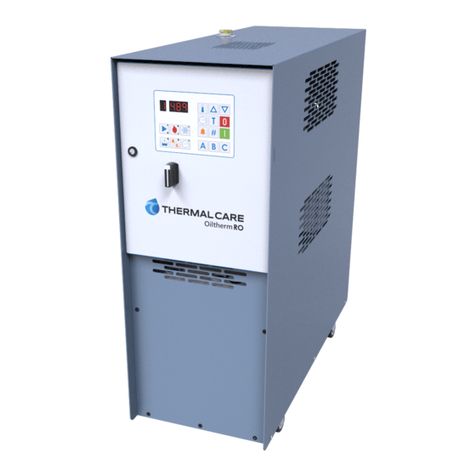
Thermal Care
Thermal Care Oiltherm RO Instruction Manual
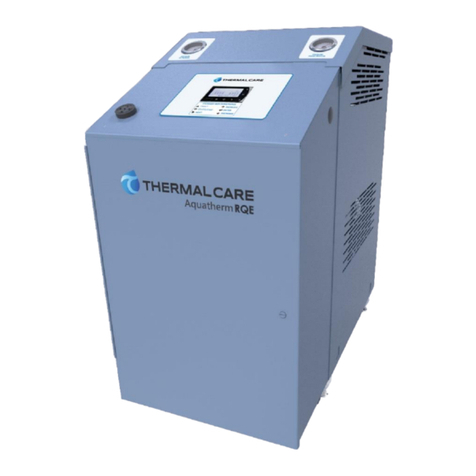
Thermal Care
Thermal Care Aquatherm RQE Instruction Manual

Thermal Care
Thermal Care Aquatherm RQE Instruction Manual
